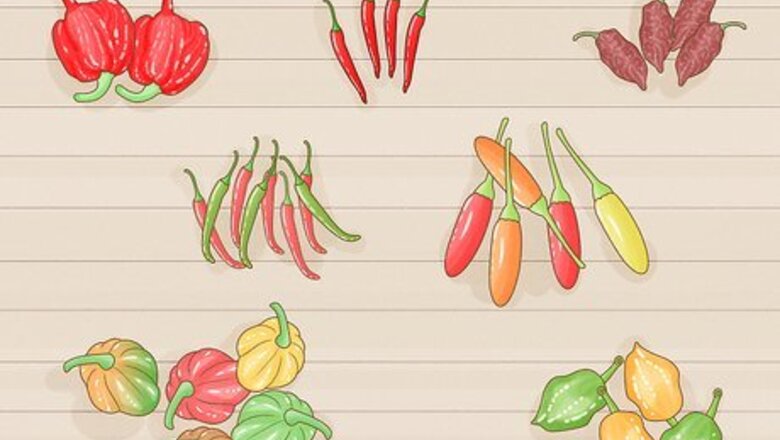
views
Planting the Chilies
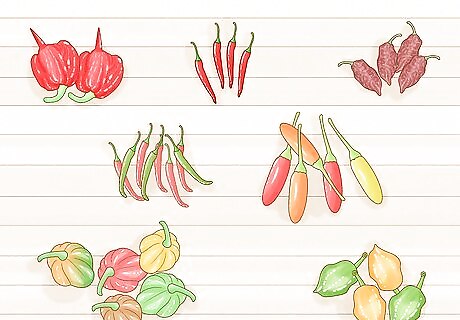
Select a variety of chili pepper that's high on the Scoville heat scale. Read the description on the seed package or plant start to find a variety that matches the flavor and heat level you're looking for. Some might list the Scoville heat unit (SHU). The higher this number, the hotter the pepper. Here are some popular spicy peppers you can grow at home: Cayenne pepper: 25,000 to 50,000 SHU Tabasco pepper: 30,000 to 50,000 SHU Thai pepper: 50,000 to 100,000 SHU Habanero pepper: 100,000 to 350,000 SHU Scotch bonnet pepper: 100,000 to 350,000 SHU Ghost pepper (also called Bhut Jolokia): 1,041,427 SHU Carolina reaper: over 2,000,000 SHU
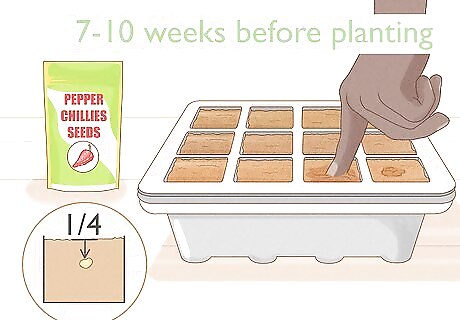
Germinate the seeds in soil 7 to 10 weeks before you plant them. Fill a seed tray with soil and plant the seeds ⁄4 inch (0.64 cm) deep. Then, water the soil whenever it starts to dry out. Set your seed tray in a sunny spot during the day and put a grow light over it at night so the seeds get 16 hours of light a day. Keep the seeds indoors for 7 to 10 weeks until they grow into starts. If you want to grow a pepper start instead of working with seeds, skip this step. To speed up germination time by 1 to 2 weeks, soak the seeds in water for 2 to 8 hours before you plant them in the trays.
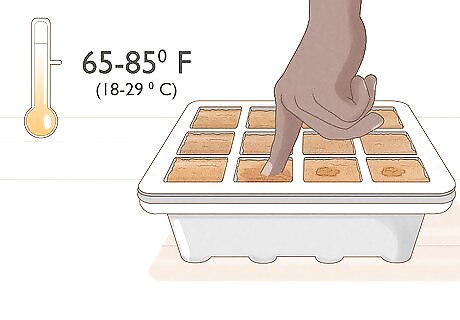
Wait to plant the starts until the last frost date in your area has passed. Your chili peppers will take a lot longer to grow and they'll be mild if you plant them when the weather is still chilly. Wait to plant the chili pepper starts until the daytime temperatures are between 65 and 85 °F (18 and 29 °C) and you're past the last frost date in your region. If you get unexpected cold weather, cover the plants with garden sheeting to keep them warm.
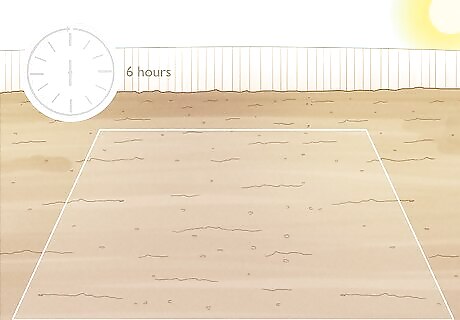
Choose a planting location that gets at least 6 hours of direct sunlight. Chili pepper plants like it hot and sunny, so find a spot in your yard that gets at least 6 hours of sunlight every day and is protected from the wind. If you're growing the chili peppers in a pot, you can easily move the peppers if you find they're not getting enough light. If you have small kids, don't plant the chili peppers near patios or walkways. You don't want the kids touching the oils from the plants which can irritate their skin.
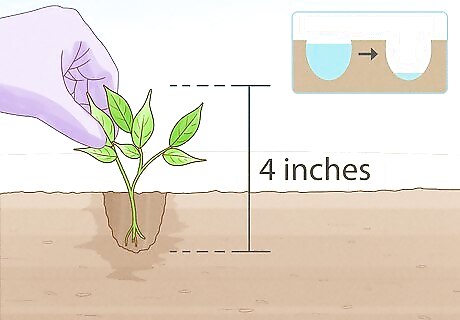
Plant the chili pepper starts in well-draining soil. Once your starts are about 4 inches (10 cm) tall, dig a 4 to 5 in (10 to 13 cm) deep hole in the soil or in a container. Plant the chili pepper start and cover the roots with soil. Then, water it and let it grow in the sun. Check the bottom of the container to see if it has holes for draining. It's important that water drains off so the roots don't rot.
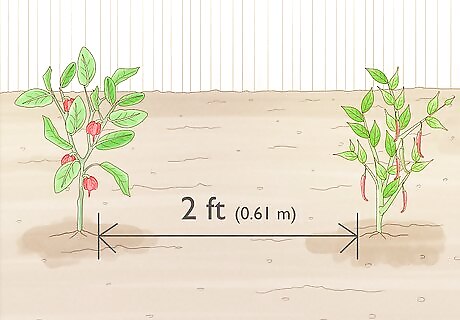
Put spicy varieties at least 2 ft (0.61 m) from mild ones to prevent cross-pollination. If you're planting the peppers in containers, don't put a mild variety in the same pot. If you're planting the chilies directly in your garden's soil, keep the spicy plants at least 2 feet (0.61 m) apart so they don't cross-pollinate with milder varieties. If you plant the spicy and mild varieties too close to each other, the mild varieties might be hotter than you want.
Stressing the Plant
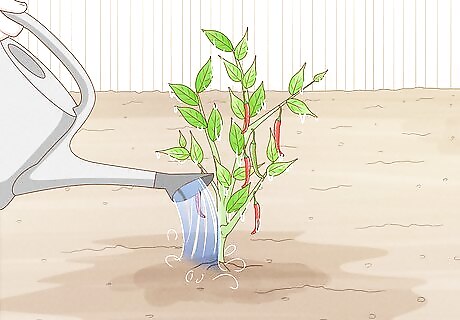
Water the established plant only when the leaves start to droop. It might feel like you're neglecting your plant, but watering it infrequently actually makes it produce more capsaicin, which means the peppers are hotter. Once your plant has flowered, watch it and only water once the leaves begin to wilt or droop. Give the soil a quick drink, but don't saturate it so much that water runs from the bottom of the pot or sits on the surface of the soil. Start limiting the water once the plant has put on some flowers. Your pepper plant won't produce as many chilies as a plant that's watered regularly, but the chili peppers will be a lot hotter.
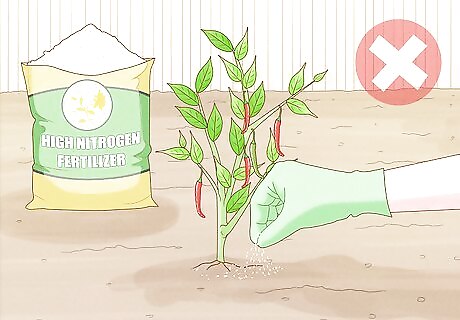
Don't use high-nitrogen fertilizer on your pepper plant. A lot of nitrogen in the soil makes your plant grow more leaves, but not more peppers. If you want to use a fertilizer because your soil is poor, choose a slow, natural fertilizer like kelp or fish emulsion. Water the plant with the fertilizer about every 2 weeks. It's fine to start the plant with soil that's high in nitrogen, but don't keep adding it once the plant flowers.
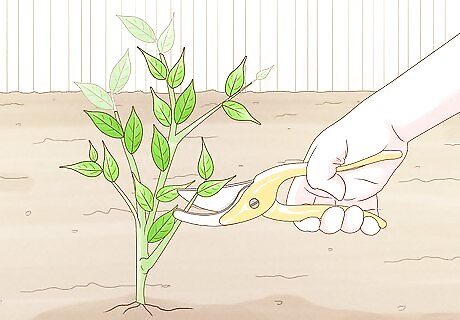
Trim the top growth and a few lower leaves from the plant to slow growth. To top a plant, cut off the growth that's just above the healthy branches at the top of the plant. Doing this and plucking a few leaves from the bottom of the plant stresses it and prevents it from putting on a lot of growth. Do this anytime the plant looks like it's growing more leaves than chili peppers. Topping and trimming leaves mimic damage from pests. When the pepper plant detects damage and stress, it starts making more capsaicin.
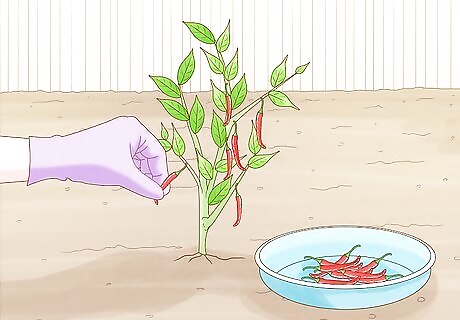
Harvest the chilies only after they've turned completely red on the vine. Don't pick your chili peppers as soon as they turn red even though they're technically ripe. Leave the peppers on the vine as long as possible because they'll keep producing capsaicin while they're on the vine. The chili peppers won't continue to get hotter once you pick them. Pick the hot peppers just before you're ready to use them. This ensures that you'll have the hottest pepper possible.















Comments
0 comment